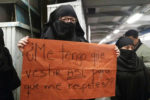The development of a university course about Muslim women in the media and the threats faced by Muslim women activists would appear to be two very different stories. Yet they were both illustrated by nearly identical photographs: a lone Muslim woman wearing black clothing + black niqab. This is far from the first time such unrelated photographs have been shoehorned into coverage of Muslim women.
While it’s tempting to stifle a yawn, these choices of stock photographs should be challenged because it is wrong on many levels. Here’s why:
Only a minority of Muslim women wear the niqab. Contrary to the bingo card-worthy cliches, most Muslim women (estimated worldwide population of over 500 million), do not live in Saudi Arabia (total population 26.2 million), or Afghanistan (total population 29.1 million), countries commonly associated with the face-veil. While face-veil wearing can be found in various forms across the world, it remains a minority practice. This remains true in the UK, where both articles were written.
Making the default as Muslim women = niqab wearer is making an inaccurate image as the default. If the media wants to talk about Muslim women, it should portray us in more representative ways, and here’s a tip: large numbers of Muslim women, if not in fact the majority, don’t wear hijab either.
Another issue with the usage of photographs of niqab wearers is that they are frequently stock photographs. They do not feature anyone actually involved in the story, but rather a Muslim women is used merely as an illustrative prop.
Then there comes the question of agency. Did the women in these photographs give their permission for their photograph to be taken? Did they agree for it to be used to illustrate news stories that discuss anything from niqab bans to domestic violence? Did they actually get paid for the photograph in the first place?
Such lazy usage of stock photographs is indicative of a wider attitude of stereotyping and dismissiveness towards Muslim women.




